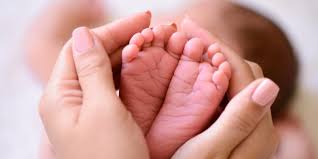US and UK moms compared

London: When the Duchess of Sussex’s stateside friends threw her the mother of all baby showers in New York, some loud tutting could be heard from across the pond.
Was it the party per se? Baby showers, are still relatively rare in the UK. Or the sheer extravagance? With a bill reported by Vanity Fair to be £150,000, a guest list that ran to Serena Williams and Amal Clooney, and a swanky Manhattan hotel as the venue, this was not a modest affair.
“We don’t do it here in the UK. It was a bit over the top in terms of expense,” the Queen’s former aide, Dickie Arbiter told US Weekly.
It’s by no means the only difference between the deeply rooted attitudes to pregnancy and childbirth in the US and the UK.
The baby shower is, in fact, a rare example of how this divide is being spanned.
“I think we’re often looking across the pond for inspiration on how to add a little pizzazz to pregnancy and motherhood,” says Rebecca Moore, editor of Little London and Baby London magazines.
A pre-birth bash has “become a huge trend for mums-to-be” says Moore.
Justine Roberts, founder of the Mumsnet parenting website, also spies the beginnings of a cultural shift, although there’s “resistance to calling it a baby shower,” she says.
What does come across “quite strongly” from British women on Mumsnet, Ms Roberts says, is “puzzlement over gender-reveal parties” – a celebration at which the expected child’s sex is announced.
Puzzlement would be an understatement for how British mothers-to-be would react to the price-tag attached to child birth in the US. With only a handful of private maternity hospitals in the UK, the vast majority of women opt for free care under the tax payer-funded NHS.
Americans are far more likely to rely on private insurance to fund their healthcare. However, many millions don’t have health insurance, according to the US Census Bureau. In 2013, research in California found women in the state could be charged anything between $3,296 (£2,501) and $37,227 (£28,254) for an uncomplicated, natural birth.
Charges for a caesarean section ranged from $8,312 (£6,315) to $70,908 (£53,817), the study published in the BMJ Open found.
Insurance companies shell out for an average 37% of the charges. But that still leaves a whopping bill for new parents, particularly those uninsured.
The BMJ study said the costs are “typically so high that few patients can afford them, resulting in need for charity care, sliding scale payments or often bad debt on the patient’s part”.
There’s also a difference in who directs the delivery. Midwives are key in the UK. A third of pregnant women saw a midwife, rather than a doctor, for their first antenatal appointment in 2015, according to the Care Quality Commission.
Women in the UK can expect to attend at least 10 midwife appointments before giving birth – and may not see a doctor at all. Latest figures show 56% of babies in the UK were delivered by midwives in 2012-13.
In the US, in 2014, 8% of births were attended by midwives, according to the American College of Nurse-Midwives.
“About 50% of counties in the US don’t even have a midwife or an obstetrician,” Dr Neel Shah, a leading US gynaecologist has told the New England Journal of Medicine..
“It’s relatively common to have to get into your car and drive some significant distances. And because of the way that we deliver babies in the US – almost exclusively in hospitals – in settings which very much look like ICUs (intensive care units), it’s a huge resource investment that would be very difficult to build at scale throughout the country.”
For a growing number in the UK, where caesarean deliveries are on the rise, midwives are having to make way for doctors. C-section deliveries have risen from a fifth of births in 2000 to more than a quarter in 2015, according to the Lancet.
The caesarean delivery rate has risen in the US too, and accounted for almost a third of births in 2017, according to latest national figures.
One of the most marked differences between the UK and US however, comes after the delivery – with maternity leave.
The US is the only country in the developed world not to offer nationwide paid maternity leave entitlement, according to the Organisation for Economic Co-Operation and Development (OECD).
“British Mumsnet users are aghast when US mothers talk about having no right to paid or unpaid leave to care for a new child or recover from childbirth, depending on which state they live in,” says Mumsnet’s Justine Roberts.
Under national (federal) law in the US, mothers are entitled to 12 weeks unpaid leave. Individual states and employers are invited to step in and pay up. But in the 25 years since the law was passed, only four states have done so: California, New Jersey, New York and Rhode Island.
What’s more, just 13% of private sector workers had access to “paid family leave” in 2017, according to the US Bureau of Labor Statistics.
In the UK, women are entitled to 39 weeks paid tax-funded statutory maternity leave, and fathers two weeks.
This gulf in ideology narrows drastically when it comes to breastfeeding. The message on both sides of the Atlantic is still very much “breast is best”.
The US and UK governments both follow the World Health Organization recommendation that babies should be exclusively breastfed up to six months and should continue to be breastfed, along with solids, until they are at least two years old.
The majority of both UK and US mothers don’t subscribe to this, although American mothers show far greater commitment than their British counterparts.m
Across the UK, between 26-30% of mothers exclusively breastfeed their babies at six to eight weeks after birth, according to latest figures. Meanwhile, just one per cent of mothers in the UK exclusively breastfed their babies at six months when the government last measured it in 2010.
In the US, latest figures show 47% of women exclusively breastfeed their babies at three months, and 25% at six months.
Finally, baby names. And there is, perhaps, more common ground in this field than anywhere else. Among the top 10 most popular names for a baby girl on both sides of the Atlantic in 2018 were Olivia, Sophia, Amelia, Ava and Mia, according to the BabyCentre website.
In America, Sophia took the top slot and was followed by Olivia, while in the UK Olivia was number one and Sophia was runner-up.
Official statistics for England and Wales have yet to be released for 2018, but the top five girls names in 2017 were Olivia, Amelia, Isla, Eva and Emily, according to the ONS.
There is less alignment on boys’ names, however, with Oliver and Noah the only two names managing to cross the Atlantic divide in 2018.
In the UK, the top five boys’ names were Muhammad, Oliver, Noah, Harry and Leo, BabyCentre said.
In the US, Jackson led the top five, followed by Liam, Noah, Aiden and Caden – with Oliver a new entry at number nine, the website said.





